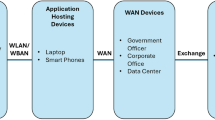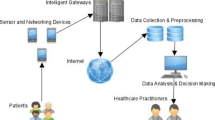Abstract
More and more IoT detection devices are entering into healthcare domain. They collect remote data through the MQTT protocol. Along with the chaos of server subscription, data format, message structure, and content parsing, how to realize the end-to-end “model-as-a-service” in the healthcare scenario is an issue worthy of further study. This paper designs and implements a healthcare data integration framework that integrates the whole process from detected data subscription to model training deployment and data analysis automatically based on workflow, and provides users with a low-code workflow configuration method. First, this paper defined a custom description language for the workflow of the integration problem. Next, fully considering the situation of message parsing and storage of different devices, we build an end-to-end healthcare integration framework that realizes the dynamic management of access data and subscription clients. In addition, it provides customization and AutoML-based automation options to select machine learning models and parameters. Finally, the experiment shows that the framework completes the dynamic subscription, parsing, storage, model training and deployment, and data analysis of various device messages. This framework can further integrate techniques such as streaming data analysis and deep learning automation to perform complex tasks in different scenarios like real-time data analysis of elderly care and medical diagnosis.
Access this chapter
Tax calculation will be finalised at checkout
Purchases are for personal use only
Similar content being viewed by others
References
Mutlag, A.A., Abd Ghani, M.K., Arunkumar, N.A., Mohammed, M.A., Mohd, O.: Enabling technologies for fog computing in healthcare IoT systems. Futur. Gener. Comput. Syst. 90, 62–78 (2019)
Thangavel, D., Ma, X., Valera, A., Tan, H.X., Tan, C.K.Y.: Performance evaluation of MQTT and CoAP via a common middleware. In: 2014 IEEE Ninth International Conference on Intelligent Sensors, Sensor Networks and Information Processing (ISSNIP), April, pp. 1–6. IEEE (2014)
Sworna, N.S., Islam, A.M., Shatabda, S., Islam, S.: Towards development of IoT-ML driven healthcare systems: a survey. J. Netw. Comput. Appl. 196, 103244 (2021)
Kulkarni, A., Sathe, S.: Healthcare applications of the internet of things: a review. Int. J. Comput. Sci. Inf. Technol. 5(5), 6229–6232 (2014)
Santos, J.: E‐service quality: a model of virtual service quality dimensions. Managing Serv. Qual.: an Int. J (2003)
Laplante, P.A., Laplante, N.L.: A structured approach for describing healthcare applications for the internet of things. In: 2015 IEEE 2nd World Forum on Internet of Things (WF-IoT), pp. 621–625. IEEE (2015) December
Alfian, G., Syafrudin, M., Ijaz, M.F., Syaekhoni, M.A., Fitriyani, N.L., Rhee, J.: A personalized healthcare monitoring system for diabetic patients by utilizing BLE-based sensors and real-time data processing. Sensors 18(7), 2183 (2018)
Yang, Z., Zhou, Q., Lei, L., Zheng, K., Xiang, W.: An IoT-cloud based wearable ECG monitoring system for smart healthcare. J. Med. Syst. 40(12), 1–11 (2016)
Laport, F., Dapena, A., Castro, P.M., Vazquez-Araujo, F.J., Iglesia, D.: A prototype of EEG system for IoT. Int. J. Neural Syst. 30(07), 2050018 (2020)
Yacchirema, D., de Puga, J.S., Palau, C., Esteve, M.: Fall detection system for elderly people using IoT and big data. Procedia Comput. Sci. 130, 603–610 (2018)
Kadarina, T.M., Priambodo, R.: Monitoring heart rate and SpO2 using thingsboard IoT platform for mother and child preventive healthcare. In: IOP Conference Series: Materials Science And Engineering, vol. 453, No. 1, p. 012028. IOP Publishing (2018) November
Otto, C., Milenković, A., Sanders, C., Jovanov, E.: System architecture of a wireless body area sensor network for ubiquitous health monitoring. J. Mob. Multimedia 1, 307–326 (2006)
Xiao, F., Zhang, W.H., Wang, D.H.: Overview of workflow technology in scientific process. Appl. Res. Comput. 28(11), 4013–4019 (2011)
Hollingsworth, D., Hampshire, U.K.: Workflow management coalition: the workflow reference model. Document Number TC00-1003 19(16), 224 (1995)
Light, R.A.: Mosquitto: server and client implementation of the MQTT protocol. J. Open Source Softw. 2(13), 265 (2017)
Russel, S.J., Norvig, P.: Artificial Intelligence–A Modern Approach, pp. 736–741. Person Education Inc., New Jersey (2003)
McCracken, D.D., Reilly, E.D.: Backus-naur form (bnf). In: Encyclopedia of Computer Science, pp. 129–131 (2003)
Mishra, B., Kertesz, A.: The use of MQTT in M2M and IoT systems: a survey. IEEE Access 8, 201071–201086 (2020)
Babu, B.S., Ramanjaneyulu, T., Narayana, I.L., Srikanth, K., Sindhu, D.H.: Smart vehicle management through IoT. Int. J. Emerg. Trends Technol. Comput. Sci. (IJETTCS) 5(3), 26–31 (2016)
Young, M.: An automated framework to derive model variables from open transport data using R, PostgreSQL and OpenTripPlanner (2016)
Acknowledgment
This work is supported by the National Natural Science Foundation of China (61832014,61972276,62032016), and the Foundation of Jiangxi Educational Committee (GJJ210338).
Author information
Authors and Affiliations
Corresponding author
Editor information
Editors and Affiliations
Rights and permissions
Copyright information
© 2023 ICST Institute for Computer Sciences, Social Informatics and Telecommunications Engineering
About this paper
Cite this paper
Fang, Y., Gao, C., Zhou, X., Xiao, J., Feng, Z. (2023). A Framework for Healthcare Data Integration Based on Model-as-a-Service. In: Cao, Y., Shao, X. (eds) Mobile Networks and Management. MONAMI 2022. Lecture Notes of the Institute for Computer Sciences, Social Informatics and Telecommunications Engineering, vol 474. Springer, Cham. https://doi.org/10.1007/978-3-031-32443-7_11
Download citation
DOI: https://doi.org/10.1007/978-3-031-32443-7_11
Published:
Publisher Name: Springer, Cham
Print ISBN: 978-3-031-32442-0
Online ISBN: 978-3-031-32443-7
eBook Packages: Computer ScienceComputer Science (R0)




